Hot Honey Lemon Pepper Grilled Lobster Tails
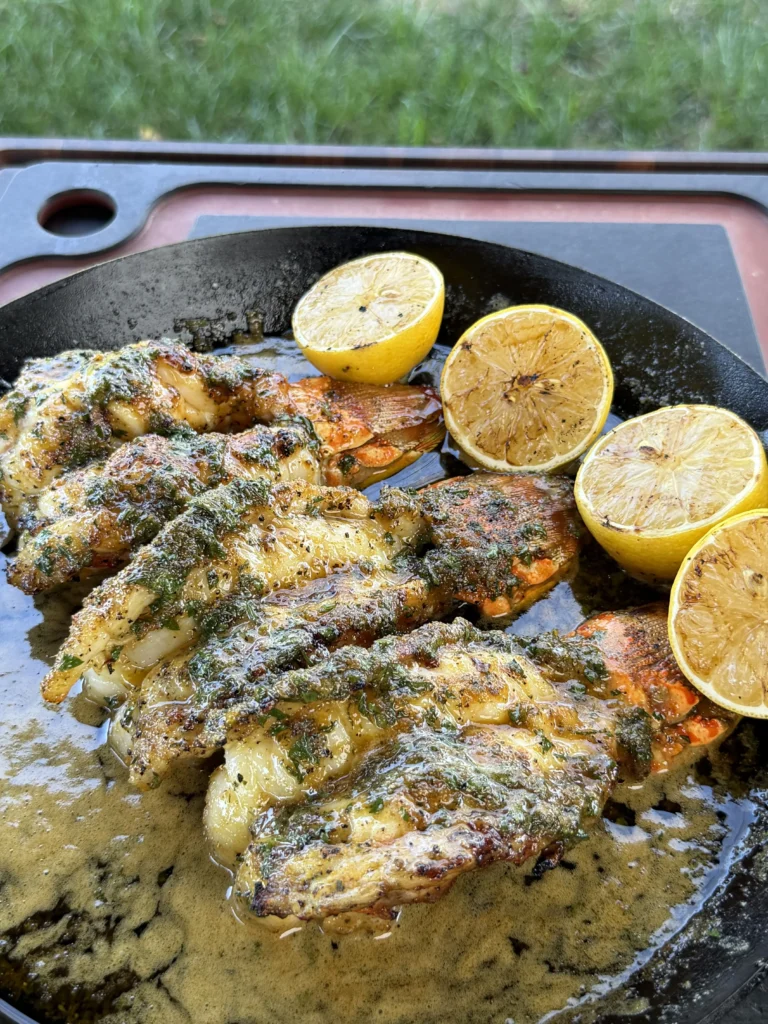
Hot Honey Lemon Pepper Grilled Lobster Tails
Butterflied lobster tails grilled outside the shell with charred perfection, basted in sweet-spicy hot honey lemon pepper butter
Ingredients
- 2 lobster tails (6-8 oz each), thawed if frozen
- 3 tbsp unsalted butter, melted
- 1 ½ tbsp hot honey (or honey + pinch red pepper flakes)
- Zest of 1 lemon
- Juice of ½ lemon
- 1 tsp cracked black pepper
- ½ tsp garlic powder
- ½ tsp smoked paprika (optional)
- Pinch of kosher salt
- Fresh parsley, for garnish
- Lemon wedges, for serving
Hot Honey Lemon Pepper Grilled Lobster Tails – Charred to Perfection
Hot honey lemon pepper grilled lobster tails represent the perfect fusion of sweet, spicy, and smoky flavors applied to one of the ocean’s most luxurious proteins. These butterflied lobster tails get their meat carefully lifted from the shell and grilled directly over flames, creating gorgeous char marks and caramelization that you simply can’t achieve when lobster cooks inside its protective shell. The constant basting with hot honey lemon pepper butter keeps the delicate meat juicy while building layers of complex flavor.
What makes this grilled lobster tail recipe special is the technique of grilling the meat outside the shell while keeping the tail fin attached for dramatic presentation. This method exposes maximum surface area to direct heat, developing a steak-like char and smoky depth that elevates lobster beyond simple steaming or broiling. The contrast between the charred exterior and tender, buttery interior creates textural interest in every bite.
This charred lobster tail recipe delivers restaurant-quality results in under 25 minutes total. The hot honey provides sweet heat that complements lobster’s natural sweetness, while lemon pepper adds brightness and aromatic complexity. The technique looks impressive but requires minimal skill – if you can butterfly a lobster tail and manage grill temperature, you can master this dish. Perfect for special occasions, date nights, or anytime you want to create an unforgettable seafood experience.
Understanding Lobster Tail Selection and Preparation
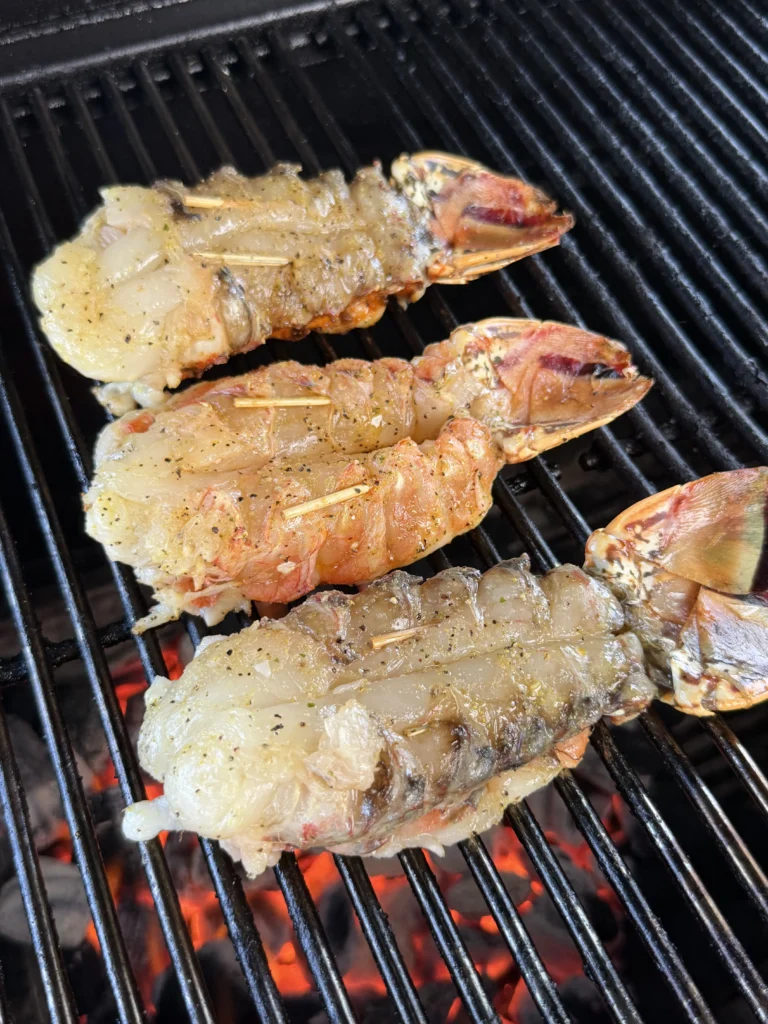
Choosing the right lobster tails is crucial for grilling success. Cold water lobster tails from Maine or Canada offer superior flavor and texture compared to warm water varieties. Cold water tails have firmer, sweeter meat with better texture for grilling. Look for tails in the 6-8 ounce range – large enough to be impressive but small enough to cook evenly over high heat. Frozen tails work perfectly well if properly thawed in the refrigerator overnight.
The shell color of raw lobster tails varies from mottled brown-green to reddish depending on the source, but this doesn’t affect quality. What matters is that the meat looks translucent and grayish-white when raw, with no yellowing or strong fishy smell. The shell should be intact without cracks, and frozen tails shouldn’t show signs of freezer burn. Quality lobster tails smell like clean ocean water, not ammonia or fishiness.
Thawing frozen lobster tails properly prevents texture issues. Never thaw at room temperature or in hot water, which can create uneven thawing and potential food safety issues. The best method is overnight in the refrigerator, placed in a bowl to catch any liquid. For faster thawing, seal tails in a plastic bag and submerge in cold water for 30-60 minutes, changing the water every 15 minutes. Properly thawed lobster should be cold but pliable, not icy or warm.
The butterflying and meat removal technique requires kitchen shears and a gentle touch. Sharp kitchen shears cut through the shell cleanly without crushing it, while your fingers can separate the delicate meat from the shell membrane without tearing. This prep work is easier than it looks and becomes second nature after doing it once or twice. The key is working slowly and deliberately rather than forcing anything.
The Magic of Hot Honey Lemon Pepper Butter
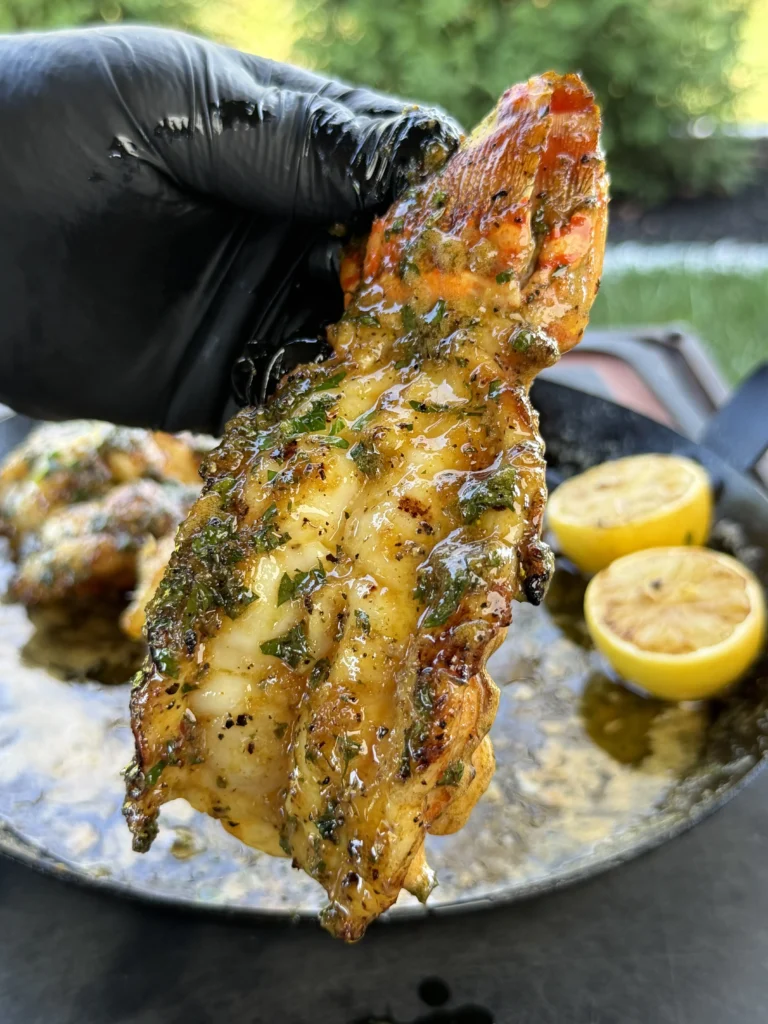
Hot honey has become a culinary phenomenon because it delivers complexity in a single ingredient – floral sweetness from honey balanced with capsaicin heat from chili peppers. When combined with butter, it creates a basting sauce that caramelizes beautifully on grilled lobster while adding sweet-spicy depth. The honey sugars develop char and crust while the heat provides contrast to lobster’s natural sweetness.
Lemon zest and juice serve different but complementary purposes in the butter. The zest contains aromatic oils that provide bright, citrusy fragrance without acidity. The juice adds tangy brightness that cuts through rich butter and sweet honey, preventing the sauce from becoming cloying. Together, they create a balanced citrus profile that enhances rather than masks the lobster’s delicate flavor.
Cracked black pepper provides aromatic spice and slight heat that builds with each bite. Freshly cracked peppercorns have more complex flavor than pre-ground, with floral and woody notes beyond simple heat. The coarse texture also creates textural interest in the butter sauce. Combined with garlic powder and smoked paprika, the pepper creates a savory backbone that grounds the sweet and acidic elements.
The butter itself acts as a carrier for all these flavors while providing rich, luxurious mouthfeel. As it melts over hot lobster, it creates an instant sauce that coats every surface. The fat helps conduct heat evenly during grilling and prevents the delicate meat from drying out. Using unsalted butter lets you control the salt level precisely – lobster is naturally briny and needs minimal additional salt.
Why Grilling Meat Outside the Shell Works
Cooking lobster meat directly on grill grates instead of in the shell creates entirely different results than traditional methods. The shell acts as insulation, steaming the meat and preventing browning. Removing the meat allows direct heat contact, creating Maillard reaction – the chemical process that develops complex, savory flavors and caramelized crust. This char is what transforms good grilled lobster into great grilled lobster.
The exposed meat also absorbs smoke flavor from the grill, adding another layer of complexity impossible to achieve with shell-on cooking. Wood or charcoal smoke penetrates the delicate meat, infusing it with subtle smokiness that complements the sweet lobster flavor. Gas grills work well too, though they provide less smoke character. The key is the direct heat exposure that shell-on methods can’t provide.
Keeping the tail fin attached serves both practical and aesthetic purposes. The shell and fin create a natural handle for moving the lobster on and off the grill without touching the delicate meat. They also provide dramatic presentation – the meat appears to emerge from the shell in a way that looks impressive on the plate. This technique is often called “piggyback” style when the meat rests on the shell, but grilling completely outside takes it further.
The risk of grilling meat outside the shell is drying out, which is why constant basting is essential. Without the shell’s protection, lobster can go from perfect to rubbery in 30 seconds. The hot honey lemon pepper butter provides moisture and creates a barrier that slows moisture loss. Basting every 60-90 seconds keeps the surface wet while building flavor with each application.
Temperature Control and Timing
Medium-high heat around 400-425°F is ideal for grilling lobster tails. This temperature is hot enough to create char and caramelization quickly but not so hot that the exterior burns before the interior cooks through. Lobster meat is delicate and cooks fast – it goes from translucent to opaque in minutes, so aggressive heat management is crucial for success.
The 3-4 minute per side timing works for 6-8 ounce tails at proper temperature. Smaller tails need less time, larger ones need slightly more, but lobster cooks so quickly that you’re always within a narrow window. The meat is done when it reaches 140-145°F internal temperature and has turned completely opaque white with no translucent areas remaining. Overcooking creates rubbery texture, so pull it just as it reaches temperature.
Visual cues are equally important as temperature. Properly cooked lobster meat is white and opaque with a slight firmness when pressed – it should spring back gently. The char marks should be golden brown to dark brown, not black and burnt. The basting butter will be bubbling and slightly caramelized on the surface. If you see the meat starting to curl excessively or the edges getting dark, it’s time to pull it immediately.
Carryover cooking continues even after removing lobster from the grill, so pull it slightly before it seems completely done. The residual heat will finish the cooking while you plate and garnish. This is especially important with lobster, which has no fat marbling to keep it juicy like beef. Once overcooked, there’s no recovery – it’s rubbery and dry regardless of how much butter you add after the fact.
Ingredients
- 2 lobster tails (6-8 oz each), thawed if frozen
- 3 tbsp unsalted butter, melted
- 1 ½ tbsp hot honey (or honey + pinch red pepper flakes)
- Zest of 1 lemon
- Juice of ½ lemon
- 1 tsp cracked black pepper
- ½ tsp garlic powder
- ½ tsp smoked paprika (optional)
- Pinch of kosher salt
- Fresh parsley, for garnish
- Lemon wedges, for serving
Step-by-Step Instructions
Butterfly and Prepare the Lobster Tails
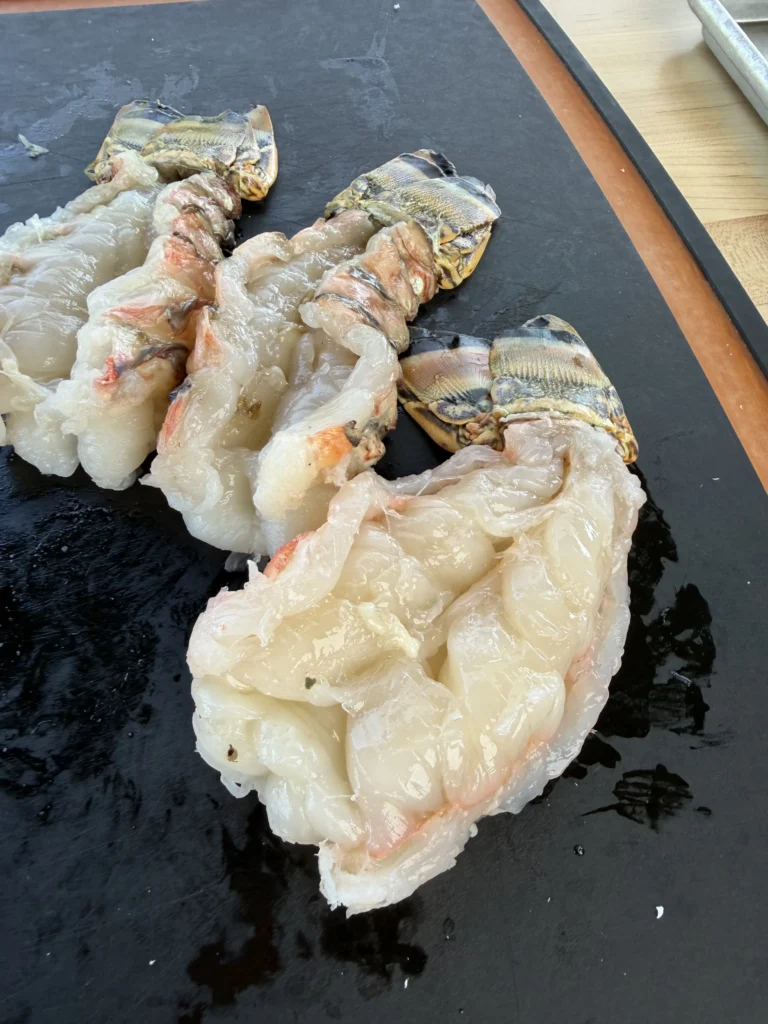
Place your thawed lobster tails shell-side up on a clean cutting board. Using sharp kitchen shears, cut straight down the center of the top shell, starting from the wide end and stopping just before you reach the tail fin. Don’t cut through the fin itself – it stays intact for presentation. The cut should go through the shell but not into the meat below. Apply steady pressure with the shears rather than trying to force through in one motion.
Once cut, use your thumbs to gently spread the shell halves apart, creating a butterfly opening. You’ll see the lobster meat sitting in the shell with a thin membrane holding it in place. Carefully slide your finger between the meat and the shell to loosen it, working from the cut edge toward the sides. The membrane should release fairly easily – if you feel resistance, work more gently to avoid tearing the delicate meat. Continue until the meat is completely separated from the shell but still attached at the tail fin. Carefully lift the entire piece of meat out and up, letting it rest temporarily on your work surface while you prepare the butter.
Make the Hot Honey Lemon Pepper Butter
In a small bowl, combine the melted butter with hot honey, stirring until the honey dissolves completely into the butter. The mixture should be uniform without streaks of honey. Add the lemon zest, lemon juice, cracked black pepper, garlic powder, smoked paprika if using, and a pinch of kosher salt. Whisk everything together thoroughly until well combined and slightly emulsified.
The butter mixture should have a beautiful golden color from the honey with visible flecks of lemon zest and black pepper throughout. Taste it and adjust seasoning if needed – it should be sweet with noticeable heat, bright citrus notes, and aromatic pepper. Set aside about one-third of the butter in a separate small bowl for finishing after grilling. The remaining two-thirds will be your basting butter during cooking. Keep both portions warm so the butter stays liquid and easy to brush.
Preheat and Prepare the Grill
Heat your grill to medium-high heat, targeting 400-425°F at the grate level. For gas grills, preheat with the lid closed for 10-15 minutes on high, then adjust burners to maintain temperature. For charcoal, arrange hot coals for direct cooking and let them ash over completely before cooking. The grates should be clean and hot – use a grill brush to remove any debris, then lightly oil the grates using tongs and a paper towel dipped in high-heat oil.
Have all your tools ready before the lobster goes on: basting brush, tongs, instant-read thermometer, and a plate for the finished tails. Set up your work area so the butter is within easy reach but not so close to the grill that it melts too much. You’ll be basting frequently, so everything needs to be positioned for quick access. The grill should be hot enough that you can only hold your hand about 6 inches above the grates for 2-3 seconds before pulling away.
Season and Initial Butter Application
Brush the lobster meat generously on all sides with the hot honey lemon pepper butter, making sure every surface is coated. The butter will help the meat not stick to the grill grates while providing the first layer of flavor. Don’t be shy with this initial application – the meat should glisten with butter. Pay special attention to any thicker portions that might need more moisture during cooking.
Position the lobster meat directly on the hot grill grates with the tail fin portion hanging off the edge or positioned so it won’t burn. The meat should be arranged so the thickest part is over the hottest zone of your grill. You should hear an immediate sizzle when the meat makes contact. Close the grill lid and set a timer for 90 seconds – you’ll be basting soon.
Grill the First Side with Constant Basting
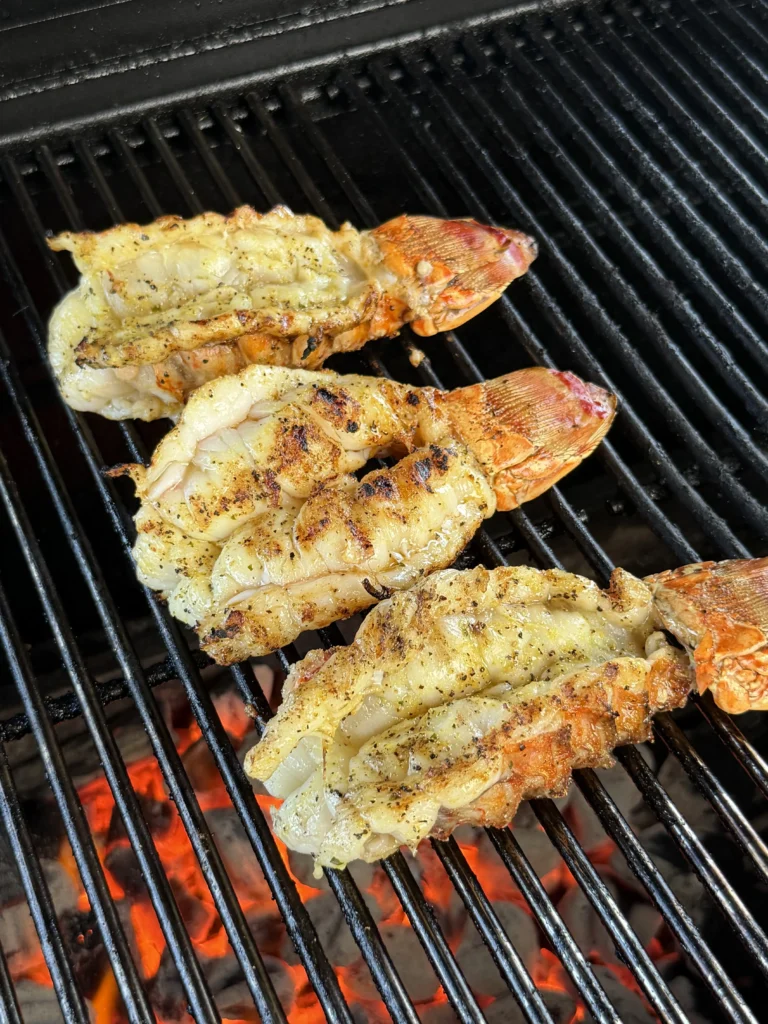
After 90 seconds, open the grill and use your basting brush to apply more hot honey lemon pepper butter over the exposed surface of the lobster meat. The butter will sizzle and start to caramelize, creating those flavorful brown spots. Close the lid and cook another 90 seconds. Open and baste again, checking for char development. The meat should be developing golden-brown grill marks and the surface should look slightly caramelized from the honey.
Continue this basting cycle every 60-90 seconds for a total of 3-4 minutes on the first side. Watch for the meat to start turning from translucent gray to opaque white – this change begins at the edges and works toward the center. The underside in contact with the grill should have distinct char marks without being black or burnt. If you see excessive charring or smell burning, reduce heat slightly or move to a cooler zone.
Flip and Finish the Second Side
Using tongs, carefully flip the lobster meat to the other side. The first side should be beautifully charred with golden-brown marks and an opaque white color. Immediately brush the now-upward-facing cooked side with more butter – this helps it stay moist while the second side cooks. The second side typically needs slightly less time than the first since the meat is already partially cooked through.
Baste every 60-90 seconds just as you did with the first side, watching the color change closely. Check internal temperature after 2 minutes on the second side – insert an instant-read thermometer into the thickest part of the meat. You’re looking for 140-145°F. When it reaches 140°F, the meat should be completely opaque white with no translucent areas, slightly firm to the touch, and have char marks on both sides. Pull it immediately when it reaches this point.
Rest and Finish with Reserved Butter
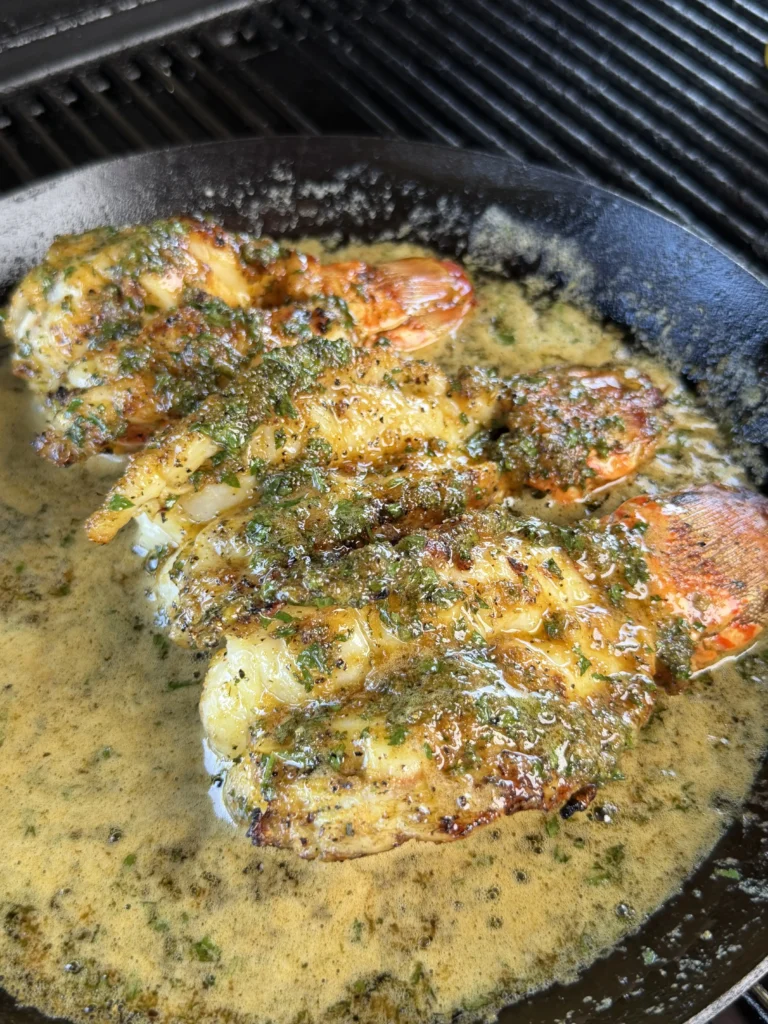
Transfer the grilled lobster tails to a serving plate and let them rest for 2-3 minutes. This brief rest allows the proteins to relax slightly and helps the meat retain its juices. While resting, the internal temperature will rise a few degrees to finish cooking through completely. The meat should be tender when pressed, with a slight firmness that indicates perfect doneness.
Drizzle the reserved hot honey lemon pepper butter generously over the lobster meat. This fresh butter application adds a final layer of flavor and glossy richness without the slightly caramelized taste of the basting butter. The clean, bright notes of lemon and honey come through more clearly in this finishing butter. Garnish with freshly chopped parsley for color and a hint of herbaceous freshness that complements the citrus notes.
Plate and Serve
Arrange the lobster tails on individual plates or a serving platter, positioning them so the charred meat is prominently displayed with the tail fin creating a dramatic backdrop. The contrast between the bright red shell, charred golden meat, and bright green parsley creates beautiful visual appeal. Provide lemon wedges on the side for those who want extra citrus brightness.
Serve immediately while the lobster is hot and the butter is still melted and glossy. The meat should be tender enough to cut with just a fork, no knife needed. Any butter that pools on the plate becomes a sauce for dipping – encourage guests to use every drop. These lobster tails pair beautifully with grilled steak for surf and turf, alongside roasted vegetables, or over rice pilaf that soaks up the flavorful butter.
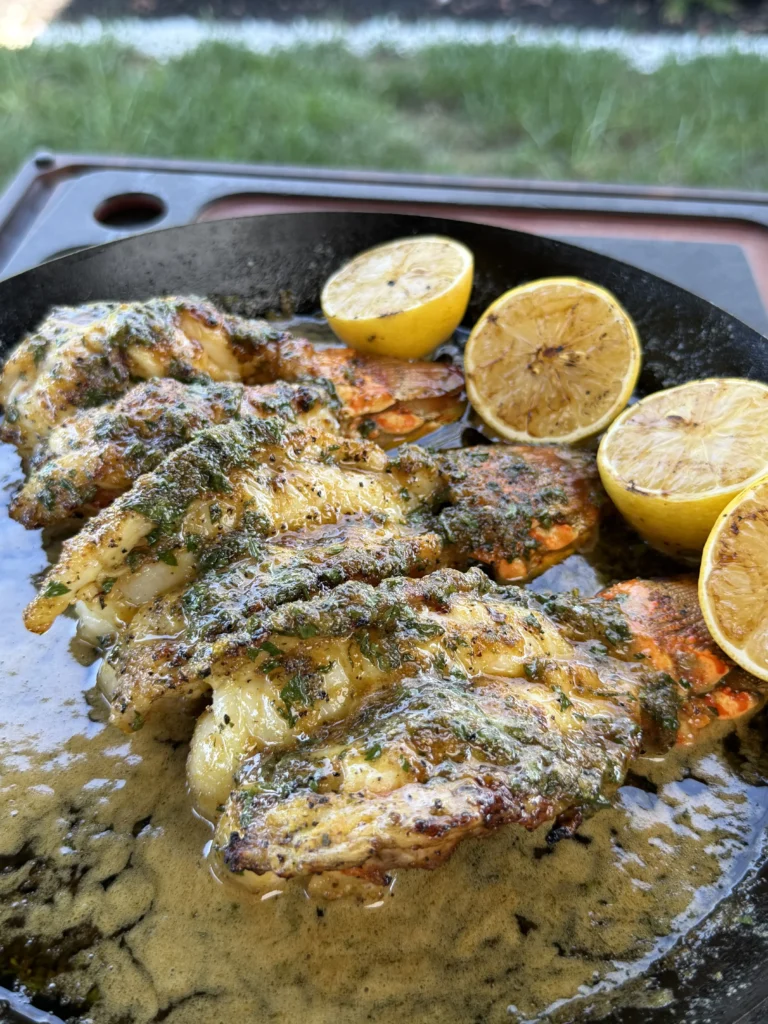
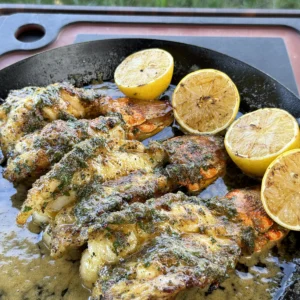
Hot Honey Lemon Pepper Grilled Lobster Tails
Ingredients
- 2 lobster tails 6-8 oz each, thawed
- 3 tbsp unsalted butter melted
- 1 ½ tbsp hot honey
- Zest of 1 lemon
- Juice of ½ lemon
- 1 tsp cracked black pepper
- ½ tsp garlic powder
- ½ tsp smoked paprika optional
- Pinch of kosher salt
- Fresh parsley for garnish
- Lemon wedges for serving
Instructions
- Using kitchen shears, cut down center of lobster shell from wide end to tail fin (don’t cut the fin). Spread shell halves apart.
- Slide finger between meat and shell to loosen completely. Lift meat out of shell, keeping it attached at tail fin.
- Make butter: Combine melted butter, hot honey, lemon zest, lemon juice, black pepper, garlic powder, smoked paprika, and salt. Mix well. Reserve 1/3 for finishing.
- Preheat grill to medium-high heat (400-425°F). Clean and oil grates.
- Brush lobster meat generously with hot honey lemon pepper butter on all sides.
- Place lobster meat directly on grill grates, tail fin hanging off edge. Close lid.
- Baste every 60-90 seconds with butter mixture. Grill 3-4 minutes total on first side until meat starts turning opaque and char marks develop.
- Flip lobster and baste immediately. Continue basting every 60-90 seconds.
- Cook second side 2-3 minutes until internal temperature reaches 140-145°F and meat is completely opaque white. Remove from grill.
- Let rest 2-3 minutes. Drizzle with reserved butter, garnish with parsley, and serve with lemon wedges.
Notes
Pull at 140°F – carryover cooking will finish it
Cold water lobster tails have better flavor than warm water
Can add cayenne to butter for extra heat
If you’re looking for more recipes , click the link! Check out all of our grilling recipes here for more steak, seafood, and BBQ favorites that are perfect for your next cookout.
COMMON ITEMS USED IN THESE RECIPES
Hasty Bake Charcoal Grill and Smoker
Knitted Gloves
Food Processor
Cast Iron Skillet
Meater +
Upgrade Your Meat Game with Grill Nation x Linz Heritage Angus
If you really want to take your grilling and cooking to the next level, you need to check out our collaboration with Linz Heritage Angus. We’ve partnered with them to bring you some of the best beef you can get your hands on.
Linz Heritage Angus isn’t your typical grocery store meat. These guys are the real deal – they raise their cattle the right way, and you can taste the difference in every bite. We’re talking about beef that’s been dry-aged to perfection, with marbling that makes your mouth water just looking at it.
Check out these premium cuts that’ll change how you think about beef:
Premium Ribeye Steaks – Perfect for special occasions
Dry-Aged Beef Selection – Take your grilling to the next level
Ground Beef & Burger Blends – The foundation of great BBQ
Use code GN15 at checkout for 15% off your first order. Trust me, once you try Linz Heritage Angus, you’ll never want to go back to regular store-bought beef.